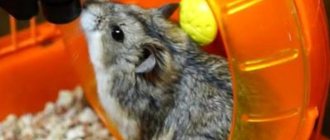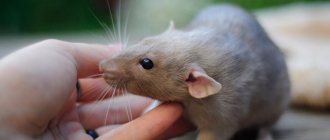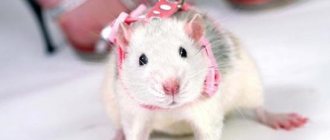When purchasing a rodent as a pet, many people wonder whether hamsters drink water. After all, it depends on whether you need to buy a drinking bowl. Opinions on the Internet on this matter differ - some believe that these animals receive enough fluid from succulent food (fruits, vegetables, berries). Others argue that water is essential for a hamster.
Do hamsters need water?
Like any living organism, hamsters need water. When an animal consumes dry food that contains fiber, it is necessary to replenish the water balance for the proper functioning of the digestive organs . The coarse fibers of the grains swell and fill the animal’s stomach. It is believed that moisture-rich vegetables compensate for the lack of water, but this is not so.
Unlike hamsters living in the steppes, pets eat more vegetables and fruits. The demand for liquid is determined by the breed of the animal, gender and ambient temperature.
More active pets, pregnant and lactating females consume more moisture . In summer, the need for water increases.
Important! By replacing water with succulent food, the pet’s body does not receive enough dry food, so replacing water with vegetables is unacceptable.
How long can a hamster live without water? It all depends on how active the individual is and what food it eats. But, it is better not to conduct experiments, and assume that it is no more than 2 days. Some hamsters can live up to a week without water, however, it is better not to leave your pet without liquid for such a long time.
Clean water is the key to your pet’s health
When choosing a drink for your pet, you need to consider some factors:
- Tap water is disinfected with chlorine dioxide. Even a minimal amount of bleach can harm a hamster's health.
- Boiling kills the presence of chlorine in the liquid, but increases the concentration of salts. Frequent consumption of boiled water can lead to diseases of the pet's genitourinary system.
- Rainwater or water from a pond must be boiled to destroy helminth eggs.
The optimal choice would be:
- Tap water that has passed through a specialized filter.
- Bottled water.
- Still mineral water with minimal levels of salts and trace elements.
- Melt water that has been deep frozen. The naturally thawed liquid does not contain harmful substances and is suitable for drinking.
How to spot the symptoms of dehydration
Symptoms of dehydration are easy to notice if you look closely:
- the homa will have sunken eyes;
- dry mucous membranes;
- the animal will be weak and lethargic;
- there may be difficulty breathing.
And in addition to the listed signs, the skin will become loose. The skin test is the fastest way to determine dehydration. You need to pinch and slightly pull the skin on the hamster's neck. If the skin immediately returns to its previous position, then everything is fine. If the skin lingers even for a short time in a raised position, the animal is dehydrated.
Milk: good or bad?
Wanting to diversify the diet, many owners treat hamsters with milk. Experts say that pregnant and lactating females should be fed dairy products . During the period of gestation and feeding, the body gives off energy and requires renewal.
4-5 grams of dissolved milk powder should be given for the first three weeks after the birth of the cubs.
If the mother dies, newborn hamsters are hand-fed with infant formula. Also, support with milk is needed for individuals who have suffered from the disease .
It is recommended to give milk to healthy and active animals no more than once a week as a reward or treat:
- It is advisable to choose milk with a minimum percentage of fat content.
- Before serving, the dairy product must be boiled and cooled for better digestibility.
- Cream, kefir, butter and cottage cheese with a high percentage of fat should be completely excluded from the diet. Products with a high proportion of fat content aggravate stomach and liver diseases.
Bowl or sippy cup?
The daily drinking rate for a healthy rodent is 5-15 ml of water per 100 g of body weight .
Using a bowl can cause constant tipping and puddles inside the cage. Litter, feces and food can also spoil the taste of the water if you use the bowl as a reservoir. The optimal solution for the animal is a water bottle. A drinking bowl attached to the walls of the enclosure saves space and easily trains the animal to drink. When you press the valve or ball at the end of the spout, water drips into the rodent's oral cavity. Most animals determine the source of moisture themselves, but sometimes help is required. Just splash a drop of water on your pet's nose.
Important! To ensure uninterrupted access to liquid for the rodent, the water in the drinking bowl should be replaced daily, and in the summer, 2-3 times a day.
Water container and daily dosage
A hamster needs easily accessible water. For this, a special drinking bowl or bowl is used. Any container is sold in pet stores and is presented in an assortment. The option with a bowl is not the best; the animal can easily pollute its water by throwing pieces of bedding in there or even turning it over. Then the floor in the cage will get wet, and the homa himself will not be able to drink.
Since the choice of special drinkers is large, it is more convenient to choose the option with a dispenser.
The daily dose depends on the breed and size of the hamster. And also on the microclimate in the apartment - how hot and dry it is in the house. It is generally accepted that these rodents require 10 milliliters of water per 100 grams of weight. This is 2 teaspoons.
Why does a rodent drink a lot of liquid?
If your pet's need for water has sharply increased, and the hamster begins to drink a lot of liquid, then you need to think about a change in behavior.
- Changes in temperature and humidity in the room. The ideal temperature is considered to be up to +22 degrees. For favorable wakefulness, it is better to move the cage with the animal to a cool place.
- Damage to the drinking bowl. It is necessary to check the connections for integrity and replace them in case of leaks.
- Changing the diet or quickly introducing a new food. It is advisable to switch to a new type of food gradually. Adding salty foods can also be a source of thirst.
If there are no changes in the activity of the rodent, then the appearance of kidney disease and the development of diabetes are possible . The main signs are:
- Eating more food.
- Rapid weight loss or obesity.
- The ruffled pose of the animal.
- Irritability and increased activity.
- Increased sleep duration.
- Frequent urine discharge, possibly with the smell of nail polish.
When your hamster drinks the weekly amount of water, you must show the animal to a doctor and begin a course of treatment.
Veterinarian: why clarify the diagnosis?
Why is a veterinarian necessary when a hamster drinks too much water?
A diagnostic test does not mean that you should prescribe treatment for your hamster. This is just a way to save time by visiting a doctor with a ready-made test. Because without treatment, as well as with an erroneous prescription, the chance of recovery for homa is very small.
- Without intervention, possible conditions such as type 1 diabetes and ketoacidosis can destroy a pet in the shortest possible time - from a few days to 2-3 weeks. As a result of the development of disorders, the hamster will first fall into a coma and then die.
- Simple carbohydrates (vegetables and grains) that will help eliminate ketoacidosis will hasten the death of a diabetic hamster and vice versa.
- Once you put someone with ketoacidosis on a low-carb diet, you can soon say goodbye to them.
- Type 2 diabetes develops much more slowly, but ultimately leads to a critical condition - hypersmolar coma with subsequent death of the animal.
- Kidney diseases can be inflammatory in nature, and they can be cured fairly quickly.
Only a veterinarian can determine how to change the diet correctly, what medications to give, how to calculate the dose and method.
Why doesn't my hamster drink water?
Sometimes the owner of a rodent is concerned about the constant level of liquid in the drinking bowl. To prevent your pet from becoming dehydrated, you need to consider several reasons:
- The hamster is not used to using the drinking bowl. You need to bring the animal to the tip of the sippy cup and moisten its face with a drop of water.
- Abundance of succulent food.
It happens that the animal is capricious and does not use the drinking bowl. Abrupt refusal may mean:
- The hamster is not satisfied with the quality of the water.
- No access possible. Different drinker configuration or malfunction.
- Musty moisture. It is necessary to wash the tank and fill it with clean water.
Watch the video on how to teach a hamster to drink from a drinking bowl.
Hamster rehydration
If your pet is slightly dehydrated because he ran out of his cage for a few hours, you need to take care of the problem by refilling the water bottle so that he drinks as much as he wants.
You should not try to bathe your pet thinking that this will quickly restore it. Hamsters do not swim in nature. Bathing will be stressful for the animal, and it may catch a cold.
When you suspect your pet is severely dehydrated or you don't know how long he's been without water, it's best to contact your veterinarian. Indeed, in some diseases, especially with diarrhea, it is not the disease itself that quickly kills, but possible dehydration.
The veterinarian will administer a saline solution with salt and mineral supplements intravenously or subcutaneously to help restore the condition.
Why does a hamster need a water bowl?
In the wild, the animal lives in the desert, so some believe that it does not need water. Hamsters get moisture from succulent food - greens, fruits and vegetables, but they need to be given water.
The liquid must be constantly changed, regardless of whether it is drunk or not. How to accustom an animal to drinking water - this will be discussed in this article.
When a new pet has arrived at home, a good owner will closely watch it and respond to all its movements. There are times when the amount of liquid in the drinker does not decrease. This means that the small animal does not drink it. In this case, the owner needs to think about why he doesn’t do this.
Dehydration: causes and symptoms
A hamster is very vulnerable to dehydration and will not survive more than a day or two on dry food alone. Here the question of whether hamsters need water is excluded. Dehydration can occur in several situations:
- Khoma worked hard in the wheel, and then he ran out of water;
- the animal is sick, its stomach is upset and there is diarrhea, then dehydration can occur, despite a full drinking bowl;
- the hamster escaped from the cage and wandered around the apartment, in which case he is also at risk of dehydration;
- the animal may get sick and stop drinking;
- your pet may have suffered heatstroke.
In any case, dehydration develops very quickly and can be fatal if the situation is not corrected.
Reasons for refusing water
First you should make sure that the animal does not drink. Djungarians need 2 ml of water per day, and the decrease in liquid from the container may not be noticed. Hamsters tend to quench their thirst at night, when the owner does not see it. If refusal to drink is beyond doubt, you should quickly understand why your hamster is not drinking water. This happens for several reasons:
- The pet simply does not want to drink. Juicy vegetables, fruits and greens in the diet can satisfy up to 98% of the animal’s water needs.
- The drinking container is fixed too high and the hamster cannot reach it.
- The drinking bowl is broken. In automatic designs, the ball of the drinking tube often jams, causing liquid to stop flowing.
- Stale drink. The unpleasant smell of water, which has not been changed for a long time, scares away the animal.
- A pet does not know how to drink from a drinking bowl - this is a problem for young animals who see the contraption for the first time.
If your hamster does not drink from the water bowl, although he used it skillfully before, you should think about visiting a veterinarian. A sudden refusal to drink when the device is working properly, the water is changed daily and the content of succulent food in the animal’s diet is low is a cause for alarm.
Features of bathing for different breeds of hamsters
When bathing, you need to take into account the characteristics of different breeds. Some are more likely to encounter water, others almost never encounter large open sources, so their fear is genetic. Another problem is the anatomical structure. Dwarf hamsters are easier to injure, so you need to be especially careful with them.
Syrians
The Syrian hamster has difficulty with bathing. It should be washed as quickly as possible, but without a strong stream of water. The animal should not be allowed to swim even in a shallow container. Syrians have weak immunity, so they can become cold and get sick. If the animal is not afraid of noise, you can dry the fur with a hairdryer on low setting.
Otherwise, wrap your pet in a towel to quickly warm him up. At the same time, this will help remove excess liquid.
Dzungariki
Problems rarely arise with this breed, since bathing a dwarf hamster is not difficult. Some animals are even happy to be in the water. Representatives of the breed have short fur, so the risk of catching a cold is lower. After the procedures, remove any remaining moisture from the fur coat with a napkin or towel. The immunity of Djungarian hamsters is stronger than that of Syrian hamsters, but after bathing it is better to remove the cage from drafts.
Djungarians have strong immunity, so the risk of catching a cold when swimming is lower.
Reasons why a hamster does not drink from the drinking bowl
There are several reasons why a small rodent does not drink water.
Let's list some of them:
- If, before purchasing, small animals were fed with special food containing a lot of moisture, then they simply did not drink liquid before and do not know its taste. You need to wet your finger in water and drop it on the animal’s nose so that it can feel its taste.
- If a rodent has changed its owner and its living conditions have changed, it needs some time to get used to the new atmosphere. Moving for an animal, as well as for people, is always a big stress. He may not only stop drinking, or even stop eating until he gets used to it.
- An animal may also not drink because it previously had a drinking bowl of a different shape, but it has not yet adapted to this one or does not know that this device contains liquid. He needs to show it and push it.
- He doesn't drink water because it's stale. The owner might have forgotten to change it and it would become stagnant. A small rodent senses this well and will not drink foul-smelling contaminated liquid. To prevent this situation from happening, you need to pour clean water daily or replenish the drinking bowl as much as the animal can drink.
- The problem may lie in the drinking device itself. The automatic device sometimes fails, a ball gets stuck in it or a valve jams. You need to check the drinker and correct any shortcomings in a timely manner or purchase a new device.
Sometimes, on the contrary, if the room temperature is too high, the hamster drinks a lot of liquid. This is a normal phenomenon, because the body’s need for moisture also depends on external factors. But if the room is cool and the animal does not touch the bowl, then it is too cold. It is necessary to provide additional heating of the room.
Water quality
The water must be fresh
Water quality also plays an important role. Animals must be given water from a spring or purified tap water. The rodent also gets moisture from vegetables and fruits. But dry food should also be included in the diet, then he will drink liquid.
The owner must constantly monitor the condition of the water, as well as the cleanliness of the bowl or automatic device. In dirty dishes, the liquid will immediately spoil. Types of drinking bowls
Novice pet lovers ask how to train a hamster to use the toilet, feeder and water bowl. First you need to decide which drinking bowl you should purchase. Types of drinking bowls:
- There is a nipple drinker with a special spout on sale; it is attached to the bars of the house. At the tip of the spout there is a valve or ball, when pressed, water flows out. The automatic device is very convenient to use; the liquid in it does not become dirty and does not spread throughout the cage when the animal drinks. It should not be placed very high so that the animal can easily reach it. The only drawback is the high price of this device.
- Instead of an automatic device, you can put a tiny bowl filled with liquid. But the animals are hyperactive, so soon it will be overturned, and the cage will have to be cleaned, since there will be food, sawdust and other debris in the bowl. A wet animal can catch a cold and even die.
It is unacceptable to use a bowl when babies live in a cage. They are very sensitive to cold and will catch a cold immediately.
Easily removable causes of thirst in a hamster
The most harmless reason for the disappearance of water is a defect in the drinking bowl, due to which water flows out on its own or during the animal’s consumption. In the second case, the hamster's face will be wet after drinking.
Uncomfortable conditions
Increased dryness in the room or temperatures above 22°C will cause increased thirst. In this case, the cage must be placed in a place where the temperature is 18-22 C.
Hamster nutrition
When you are sure that the animal is healthy, the question of why the hamster drinks a lot may lie in a change in diet. It is recommended to introduce any new diet gradually so that the animal’s body has time to smoothly readjust and get used to it.
Unsuitable food, possibly containing salt or sugar, will also make the pet experience increased thirst, here the body needs to quickly remove unnatural trace elements. Therefore, it is necessary to check whether anyone is treating the hamster with treats, for example, chips or sweet cookies.
Why doesn't my hamster drink water?
Sometimes the owner of a rodent is concerned about the constant level of liquid in the drinking bowl. To prevent your pet from becoming dehydrated, you need to consider several reasons:
- The hamster is not used to using the drinking bowl. You need to bring the animal to the tip of the sippy cup and moisten its face with a drop of water.
- Abundance of succulent food.
It happens that the animal is capricious and does not use the drinking bowl. Abrupt refusal may mean:
- The hamster is not satisfied with the quality of the water.
- No access possible. Different drinker configuration or malfunction.
- Musty moisture. It is necessary to wash the tank and fill it with clean water.
Watch the video on how to teach a hamster to drink from a drinking bowl.
There is a lot of debate about whether hamsters need to drink. The rodent is able to balance the level of fluid in the body itself, but even with low consumption, the animal cannot be denied free access to water. With timely care and attention, a small pet can delight its owner for many years.
Instructions
The new pet must be allowed to get comfortable in the house and be allowed to explore the living conditions. When he calms down, he will begin to carefully study the cell. He may not need help in mastering drinking; after a while he will discover that he drinks without prompting. If this does not happen, you can accustom your hamster to the toilet, to the feeder and drinking bowl as follows:
- Let the animal into the house, do not touch or disturb it, after a while it will be able to find water and bury its face in it.
- If the rodent does not approach the device and does not drink, you can lightly poke its muzzle into the liquid and give it a drink.
- If the animal is wild and not yet accustomed to being handled, the nipple drinking device is lubricated with something aromatic. He can't resist the smell and starts licking it. If he does not do this, you need to slip the tip of the device under his nose and teach him how to use it.
How much water do hamsters drink?
In fact, rodents don’t drink that much liquid anymore. Therefore, at first it may even seem to you that the water in the drinking bowl is not getting smaller. But that's not true. If a hamster's diet consists of succulent foods, he may not drink water at all for several days. By the way, when rodents get sick (about diseases of hamsters), first they refuse food, and then from water.
If you notice that your hamster is not eating or drinking, do not delay visiting the veterinarian.
In nature
Both the Syrian hamster and the Djungarian come from arid regions - steppes and semi-deserts. The animals avoid open bodies of water, and during rare rains they take refuge in burrows. Usually a person does not understand what desert-dwelling hamsters drink. The source of moisture for tiny animals is dew that falls at night. They lick the drops from the blades of grass to their heart's content.
What are they?
Drinkers that are used for hamsters at home can be internal or external. They differ in the method of attachment, that is, they can be located inside or outside the cage. In the second case, it turns out to save space inside the pet’s habitat, this is especially true when the home is not too large.
There are many factors to consider when selecting. This is primarily size, convenience, reliability, and method of fastening.
You should also pay attention to stability, safety for the pet, as well as the aesthetic appearance of the structure.
You can also classify devices by design type. They can be suspended or floor-mounted.
As for floor options, they are placed inside the cage. The bowl should have enough weight so that a mobile pet cannot turn it over.
However, it is necessary to take into account the following: since water is in the public domain, it becomes contaminated quite quickly, and it is still possible to accidentally knock it over.
Hanging structures can be secured inside or outside the cage. The container can be open, but closed options are still the most popular. There are vacuum designs that include a container standing on a wide tray with high sides, from which water flows. Not everyone likes this option, since the liquid gets dirty quite quickly and you need to wash the entire device to clean it. Since such drinkers are most often made of soft materials (like plastic), hamsters often chew them.
Nipple drinkers for pets include a flask from which water flows through a tube ending with a locking mechanism. The hamster gets liquid by pressing its tongue on the latch, and the animal will have to get used to this. There are also ball mechanisms that operate in a similar way to the previous one.
Such options are used especially often, because the water remains clean and does not spill throughout the cage.
Some owners choose bottle drinkers with a reservoir. Water slowly flows out of the container into a small depression. These drinkers are most often used by bird owners, but hamsters can also use them. However, with this choice, you need to take into account that the water will also be open and the structure will have to be washed and cleaned frequently.
How to do it yourself?
If you can’t buy a drinking bowl in a store, you can try making one yourself at home. This process is absolutely not complicated and does not require any special skills.
In addition, the design will require only available or inexpensive materials. They can be found in almost every home.
To make a sippy cup you will need a knife, a nail or an awl, and a plastic bottle. You also need to prepare a regular pen, a ball that will fit inside it but will not slip out, a spring from a fountain pen, wire for fixing the device, electrical tape, and glue. The procedure will not take too much time. Let's look at 2 options that are especially easy to do on your own.
In order to make a nipple drinker, you will need a small plastic bottle, a ballpoint pen and a ball. The ball must be selected so that it fits freely inside the body of the handle, but does not roll out of its narrowed part.
The place where it gets stuck is carefully cut off with a sharp knife so that the ball sticks out a little, but does not have the opportunity to roll out completely.
You can secure the ball with a pen spring, but not too tightly.
Diseases: immune, inflammatory, enzyme disorder
A hamster that drinks a lot of water and also produces a lot of urine may be suffering from one of the following diseases: diabetes, kidney inflammation, or ketoacidosis.
Diabetes
The predisposition to this disease is genetic and is inherited. Signs indicating a metabolic disorder are as follows:
- the animal’s urine will acquire a specific smell, which contains acetone, and therefore may resemble the smell of glue or nail polish;
- Homa's behavior will also undergo a change, the animal will be either lethargic or overly active;
- Appetite and appearance may not match each other.
Eating more food and losing weight at the same time clearly indicates the development of the disease.
How to exclude or confirm hamster diabetes at home
For this procedure, you need to purchase special strips from the pharmacy that detect sugar in the urine.
Attention! These are not strips for a glucometer, but specifically for urine. They are sold in cylindrical cases about 10 cm in length. The cost of these indicators is about 200 rubles per package. Most of these strips are also marked to detect ketone bodies, that is, the presence of acetone in the body.
The strip should be immersed in the hamster’s urine for a few seconds and evaluate how the indicator has changed. Typically, the scale for ketones ranges from beige to dark pink, while for sugar there is a green scale. A normal value corresponds to a sugar value from 4 to 5.5 mmol/l; after eating, this value can be higher - up to 10-12. In this case, if there is no acetone, you need to check for sugar again after 2-3 hours, keeping the hamster without food.
Refining the analysis
For the purity of measurements, it is best to take an analysis from the animal after it has slept for a long time. Having noticed such a moment, the sleepy ham needs to be placed in a clean tray. When the animal wakes up, it immediately pees. In this case, the accuracy of the test strip readings is quite high, because the hamster had a “fasting” period, because he did not eat during sleep and the concentration of substances in the urine itself increased for the same reason.
Analysis results
- If sugar is detected without acetone, then your hamster has type 2 diabetes. This disease is controlled by a low-carbohydrate diet and sugar-burning medications. In this type of diabetes, insulin is retained in the body, and therefore ketone bodies are not detected.
- If sugar and acetone are detected, your hamster has type 1 diabetes. Here, a diet is also used and the issue of insulin compensation is resolved, since in type 1 diabetes, insulin production completely stops.
Despite the general word diabetes, the mechanisms of disease development are different, as is the therapeutic approach.
Other possible diseases - kidney or pancreas
Symptoms very similar to diabetes occur with completely different ailments. Since these signs are quite similar to the diabetic profile, the disease can be excluded or confirmed by using the same test strips for determining sugar and acetone in the urine.
Sick kidneys
- the pet’s urine has changed its smell to a stronger one than before, there may be traces of blood in the urine;
- the animal’s mood has deviated from the norm - unreasonable activity or incomprehensible apathy has appeared;
- increased appetite, which is accompanied by weight loss.
If the measurement did not show any changes in either the sugar indicator or the acetone indicator, there is a possibility of inflammatory or other nature of kidney disease. The development of a tumor process cannot be ruled out.
Ketoacidosis
There is one more option for test measurements left. When only an increased level of acetone is detected in the urine, it is logical to assume non-diabetic ketoacidosis.
This condition is caused by a disorder in the production of pancreatic enzymes (not hormones as in diabetes), which results in an increase in the concentration of acetone in the body.
The disease is corrected by a balanced diet; as a rule, you need to increase the amount of carbohydrates.
How to install?
Purchasing and making a drinking bowl is not the most difficult task. It is also necessary to properly attach it to the cage so that a playful pet does not spill water and damage the structure. Store-bought copies are usually equipped with special latches, which are very convenient to use in this case.
If the drinker has a hole in the lid for fastening, but there is no latch itself, this is not a problem. It can be made from a small piece of wire, bent along the edges to form peculiar hooks. You can also use thick rope.
The main thing you need to pay attention to is that the container is held firmly on the cage, and that the pet itself does not get hurt on the protruding edges of the fastening.
You can also secure the drinker using a large plastic cup. To do this, it is turned upside down, and a hole for a drinking bowl is cut out in it. You need to make a small hole on the side into which the tube is inserted. The structure is placed quite stably inside the cage; it can be placed in any free space.
The floor drinking bowl should be equipped with a weighting material, then an active animal will not be able to turn it over. However, you need to take into account that the tank will need to be washed quite often, so you should not secure it thoroughly. It would also be appropriate to place such a structure on a stand. In this case, less dirt will also get into the water, as a result of which it will be possible to change it a little less often.
Diabetes
Sometimes the reason that a hamster drinks a lot is a rodent disease associated with an increase in sugar levels in the body. Signs of the disease are:
- Significant weight loss or, conversely, obesity.
- The animal looks hunched over.
- Increased appetite. The hamster becomes voracious and eats more often than usual.
- Irritability. If before the pet behaved calmly, then, having fallen ill, he
- becomes aggressive and bites.
- Long sleep.
- Constant thirst.
- Your hamster is urinating more often than before. Urine smells like varnish.
If the cause is diabetes, then the rodent can eat a week's worth of food in a day. This is a signal that you need to show your pet to a good veterinarian, who will prescribe adequate treatment. The disease can also be recognized using special tests. Wet a test strip with urine and then use the scales to measure your ketone and sugar levels.











